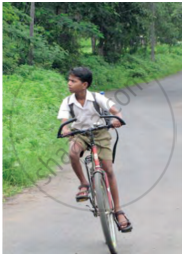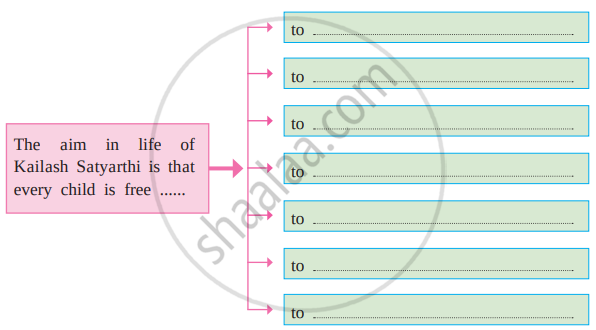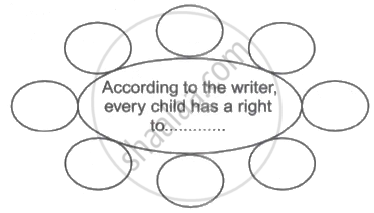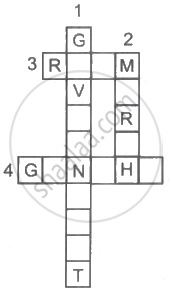Advertisements
Advertisements
प्रश्न
What does a good well-organized speech contain?
उत्तर
- A speech should be well-planned.
- The language used should be suitable for the audience.
- It should have the right duration.
- It should be supported with good examples, episodes, or visual aids, where possible.
APPEARS IN
संबंधित प्रश्न
Observe the pictures and answer.


- Main difference between the two images _______________________.
- Change required _________________________
- Your contribution as a student to help and make a difference to needy children ___________________.
Put a ✓or ×.
A good speech delivered requires the following characteristics.
Delivered softly and in a low voice.
Put a ✓or ×.
A good speech delivered requires the following characteristics.
Language used should be suitable for the audience.
Put a ✓or ×.
A good speech delivered requires the following characteristics.
The speaker should be passive and have no facial expressions.
Put a ✓or ×.
A good speech delivered requires the following characteristics.
The speech should be supported by good examples/episodes/ visual aids. (where possible)
Read the expressions and insert them in the proper columns. Put the proper expression numbers in the right column.
| Greeting/ Salutation | Introduction | Body of the Speech | Conclusion | Thanking the Audience |
Expressions:
- Imagine! After ten years, what will happen?
- Let me begin, today, by sharing my own experience.
- Honourable Chief Guest ______, eminent dignitaries, ladies, and gentlemen.
- I don’t understand why we accept this issue so passively.
- I am Adarsh Birajdar, (designation) standing before you
- A renowned personality (name) says “______”
- Good morning, to one and all present today.
- I express my deep gratitude to the organisers of this event/function ______
- Let me give you an example ______
- Thank you all for a patient listening and your interest in my talk.
- You must have noticed that ______
- Before I conclude, I would like you to think over the fact that ______
With the help of your teacher and classmates make a list of as many Indian Nobel Laureates as you can. (You can use the Internet or school library.)
| Name | Nobel Prize for |
| ________________________ | ________________________ |
| ________________________ | ________________________ |
| ________________________ | ________________________ |
| ________________________ | ________________________ |
Name the following.
The persons to whom Kailash Satyarthi gives the highest credit of his honour - ____________.
Name the following.
The greatest personalities from the land of Buddha - _________________.
Name the following.
So called daughters of Kailash Satyarthi - _________.
Mention the social issues highlighted by Kailash Satyarthi in his speech. One social issue is given to you.
| (a) Child labour | (b) ________________ |
| (c) ________________ | (d) ________________ |
| (e) ________________ | (f) ________________ |
Complete the following diagram/chart.

Complete the following web-chart.

Think and give your own response.
How can education help deprived children and child labourers?
Think and give your own response.
Besides the political freedom that our nation enjoys, what other freedom should it strive for? Say why.
Think and give your own response.
What is your impression of the acceptance speech given by Kailash Satyarthi, when he received the Nobel Prize? Write in 3 to 4 sentences.
Think and give your own response.
Name any other social activist who has worked/is working earnestly for child-welfare. Write about his/her activities.
What will you do in the following situation?
If you find a child working at a construction site.
What will you do in the following situation?
If you find a child working at a brickwork site.
What will you do in the following situation?
If you come across a beggar child.
 |
 |
Discuss in your group.
- What difference do you notice in the two images?
- Which of the two situations, should change?
- How and when can the situation change?
- How can you, as a student, contribute and help make a difference to the needy children?
The persons to whom Kailash Satyarthi gives the highest credit of his honour -
The ‘Daughters’ of Kailash Satyarthi mentioned in his speech -
The foreign activists of equal rights, mentioned in the speech -
Complete the following diagram/chart.

What will you do in the following situation?
- If you see a child working in a restaurant
- If you find a child working at a construction site
- If you find a child working at a brickwork site
- If you come across a beggar child
Write any 2 efforts that you can make to enroll deprived children/out of school children into a school. One is given for you.
- I will persuade parents of such children to send them to school.
- __________________
- __________________
- __________________
- __________________
Make a list of prestigious awards in India.
| Civilian Awards | Highest Gallantry Awards |
| (a) Bharat Ratna | (a) Paramveer Chakra |
| (b) | (b) |
| (c) | (c) |
| (d) | (d) |
| (e) | (e) |
Read the passage carefully and complete the activities:
1. Complete the following sentences. (2)
- Let us march from ignorance ______.
- Kailash Satyarthi says that today he sees thousands of ______.
- Close your eyes and feel ______.
- Let us universalise ______.
2. Complete the following web. (2)

|
TODAY, beyond the darkness, I see the smiling faces of our children in the blinking stars. TODAY, in every wave of every ocean, I see my children are playing and dancing. TODAY, in every plant, in every tree, and mountain, I see our children growing freely with dignity. Friends, I want you to see and feel this TODAY inside you. I am sure you can - Now, listen to that child. Listen, please. |
3. Write the noun forms of the following from the passage. (2)
- dark - ______
- exploit - ______
- educate - ______
- ignore - ______
4. Do as directed. (2)
- Let us democratise knowledge. (choose the correct question tag and rewrite the sentence using it)
a) will you?
b) shall we?
c) Isn’t it?
d) wasn’t it? - May I please request you to put your hand close to your heart?
(underline the ‘infinitive’)
5. Personal Response: (2)
What does honourable Kailash Satyarthi suggest us to do?
Read the following passage and do the activities.
A1. Complete the following web with the help of the passage.

A2. Who said to whom?
- "Why is he not with us in the school ?"
- "Sir, I have never thought about it. We are born to work."
|
Friends, we can do this. Governments must make child-friendly policies, and invest in education and young people. Businesses must be more responsible, accountable and open to innovative partnerships. Intergovernmental agencies must work together to accelerate action. Global civil society must rise above the business-as-usual and fragmented agendas. Faith leaders and institutions, and all of us must stand with our children. We must be bold, we must be ambitious and we must have the will. We must keep our promises. |
A3. Solve the crossword puzzle using words from passage referring to the clues given below:

| Down: | Across: |
| 1. of the people, by the people, for the people |
3. A place to rest |
| 2. To move forward | 4. Father of our nation |
A4. Do as directed:
(i) I see the smiling faces of our children in the blinking stars.
(Begin the sentence with "The smiling faces ..............)
(ii) His answer made me angry.
(Begin the sentence with "I...............)
A5. "Let us march from darkness to light" - Elaborate.
